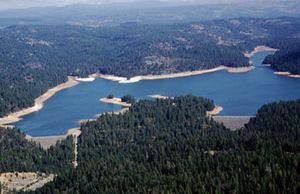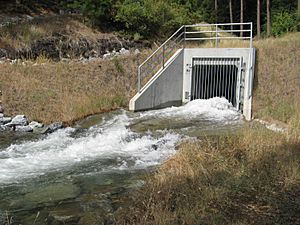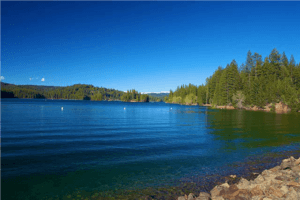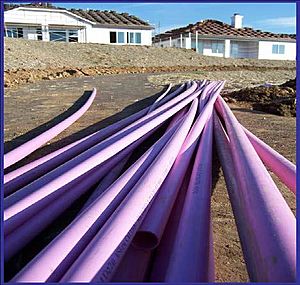Sly Park Dam facts for kids
Quick facts for kids Sly Park Dam |
|
|---|---|

Sly Park Dam (right) and auxiliary dam
|
|
| Location | El Dorado County, California |
| Coordinates | 38°42′55″N 120°33′46″W / 38.71518°N 120.5627°W |
| Construction began | 1953 |
| Opening date | 1955 |
| Operator(s) | U.S. Bureau of Reclamation |
| Dam and spillways | |
| Impounds | Sly Park Creek |
| Height | 190 feet (58 m) |
| Length | 760 feet (230 m) |
| Spillway type | Gated overflow |
| Spillway capacity | 6,700 cubic feet per second (190 m3/s) |
| Reservoir | |
| Creates | Jenkinson Lake |
| Total capacity | 41,000 acre-feet (51,000 dam3) |
| Catchment area | 47 square miles (120 km2) |
| Surface area | 650 acres (260 ha) |
| Power station | |
| Hydraulic head | 170 feet (52 m) |
| Installed capacity | None |
Sly Park Dam is a large earth-filled dam located near Pollock Pines, California, in the United States. It holds back the waters of Sly Park Creek and Hazel Creek. These creeks are natural branches of the North Fork Cosumnes River.
The dam creates a big lake called Jenkinson Lake, which covers about 650 acres. This lake can hold 41,000 acre-feet of water. The dam was built as part of the Central Valley Project. Its main job is to supply water for farming in parts of El Dorado County, California. Construction of Sly Park Dam began in May 1953 and was finished in mid-1955.
Sly Park Dam is 190 feet (58 meters) tall and 760 feet (230 meters) long. It also has a smaller helper dam, which is 130 feet (40 meters) tall and 600 feet (180 meters) long. The dam's spillway, which lets extra water out, is in the helper dam. It is a concrete chute 170 feet (52 meters) long. It can release 6,700 cubic feet (190 cubic meters) of water per second.
The area of land that drains into Sly Park Creek behind the dam is 47 square miles (120 square kilometers). A channel called the Camino Conduit moves water about 7.2 miles (11.6 kilometers) from Jenkinson Lake. This water is used for irrigation. Water from Camp Creek is also sent into Jenkinson Lake to increase the total water supply.
Contents
Jenkinson Lake and Its Surroundings
The land area that drains into Jenkinson Lake is called its watershed. This watershed covers about 16.5 square miles (43 square kilometers). It includes both branches of Sly Park Creek and Hazel Creek. Jenkinson Lake does not get enough water from this area alone. So, extra water is brought in from outside the watershed. This happens through the Camp Creek Diversion Tunnel. This area was very important during California's gold rush.
Weather Patterns Around Jenkinson Lake
The Jenkinson Lake area has a Mediterranean climate. This means it has hot, dry summers and cool, wet winters. The area is on the side of the Sierra Nevada mountains that faces the wind. Because of this, it gets a lot of rain and snow. It receives an average of 51.6 inches (131 cm) of precipitation each year.
Most of the rain and snow falls between October and May. The watershed is not high enough for snow to stay melted for a long time. The lake is important for storing water. This stored water is then used during the dry summer months.
Nature and Wildlife at Jenkinson Lake
The land around Jenkinson Lake is mountainous. It has steep slopes and rocky areas. The elevation ranges from 3,400 to 5,600 feet (1,000 to 1,700 meters). The soil here is deep and can hold a lot of water. There is a risk of landslides, which can cause dirt to wash into streams. Gold is a major mineral found here. This was a big reason why people settled in the area long ago.
The plant life includes oak woodlands and mixed conifer forests. Common trees are ponderosa pine and douglas fir. Other trees include blue oak and black oak. Smaller plants like manzanita and poison oak also grow here. These plants help keep the slopes stable. If too many plants are removed, it can increase erosion and landslides. Plants also provide homes for many animals.
Many different animals live around Jenkinson Lake. Mammals include California mule deer, black bears, and mountain lions. Birds like the mountain chickadee and Steller's jay are common. Raptors, which are birds of prey, include golden eagles and red-tailed hawks. Reptiles like rattlesnakes and gopher snakes also live here. All this wildlife makes the area a popular place for outdoor activities.
How Land Is Used Around the Lake
In the past, people used the land for mining, ranching, and cutting timber. After gold was found in California, many miners moved to the area. Farming and businesses followed the miners. A lot of water was needed for hydraulic mining. Miners built many water channels, and some are still used today. The California Gold Rush was the first big human impact on the land.
Before Sly Park Dam was built, the area where the lake is now was called Sly Park Ranch. People raised animals and farmed there. There was also a timber mill, Sly Park Mill.
Today, most of the land is used for forests and recreation. Much of it is owned by the public. Major landowners include the El Dorado Irrigation District and the US Bureau of Reclamation. Timber companies also own land and influence how trees are managed. People enjoy activities like off-road vehicle trails, mountain biking, hunting, and horseback riding.
How Water from Jenkinson Lake Is Used
Water from Jenkinson Lake is used for city water supply, farming, and recreation. In the past, farming used the most water. But as the area grows, city and business users are becoming more important. Now, city residents are the main users of water from Jenkinson Lake. Farming is still a big user, though. Future population growth and climate change will affect how water is used.
Water for Homes and Businesses
The use of water for homes and businesses is growing fastest in the El Dorado Irrigation District (EID) area. Water from Jenkinson Lake is cleaned at a treatment plant. Then, it is sent to homes and businesses throughout the EID area. Jenkinson Lake is a major source of water for the system. It is the largest lake managed by EID for water supply. Some areas rely only on Jenkinson Lake water. Pumping water from Folsom Lake can be too expensive for some parts of the district.
Water for Farms
Farming still uses a lot of water, even with the growth of towns. El Dorado County has many orchards, vineyards, and pastures. These farms need a lot of water for irrigation during certain seasons. The Apple Hill Growers Association farms are near Camino. Apple Hill has orchards, Christmas tree farms, and pumpkin patches. These places also attract tourists. While traditional animal grazing has decreased, farming water use will likely continue to grow.
Water for Fun and Recreation
The El Dorado Irrigation District (EID) manages fun activities on the lake. These include boating, hiking, horseback riding, and camping. More and more people are using the lake for recreation. Even though people doing these activities don't use much water, they can affect water quality. Pollution from boats, toilets, and erosion from off-road vehicles can make the water less clean.
Because the lake is so popular for recreation, the number of people in the area changes with the seasons. Many people have vacation homes near the lake. This means more water is needed during the summer months. This is also when there are more opportunities for fun activities.
Planning for Future Water Needs
The need for water is increasing, but water supplies are becoming less reliable. More towns and suburbs mean more demand for water. It also means more wastewater and stormwater to manage. While grazing animals is less common, other crops like fruit trees and grapes need a lot of water. Farming and the area's natural beauty have also increased tourism. The population changes with the seasons, putting more demand on water when supplies are lowest. Climate change could reduce the water available. The area has few other water sources. Many remote areas are isolated from the pipes needed to supply water from the rest of the Central Valley Project.
EID is working on ways to manage future water use. Saving water in homes and businesses is important. Encouraging water-saving appliances helps reduce water use. Finding and fixing leaks in pipes also saves water. The most important way to save water might be reusing wastewater. This is called reclaimed water. It can be used for watering lawns and golf courses. As the area grows, more wastewater is produced. By reusing this water for irrigation, the amount of fresh water needed for landscaping is greatly reduced.




